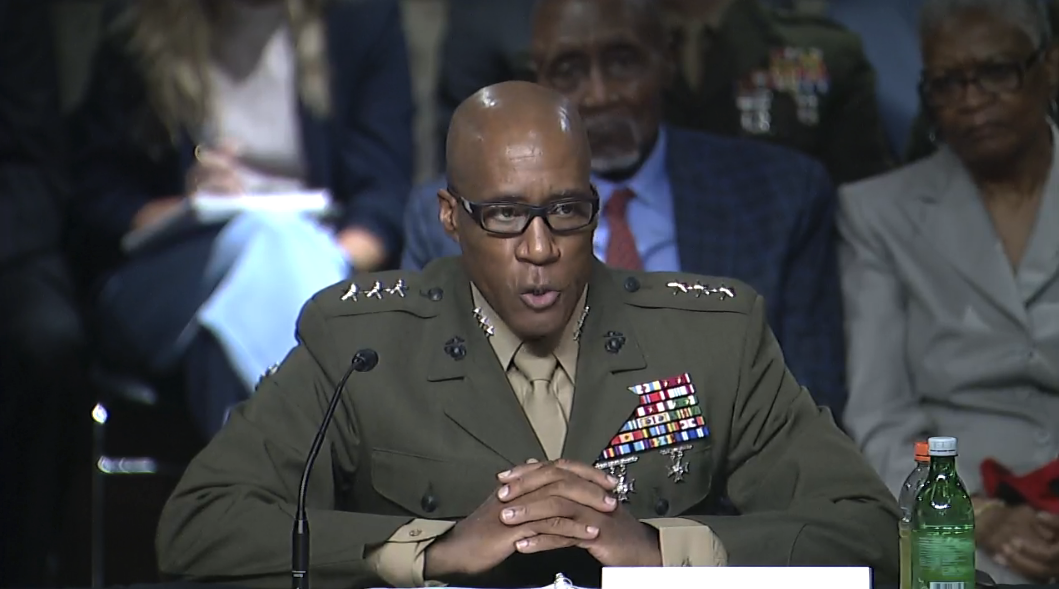US Doubles Airstrikes in Somalia, Surpassing 2024 Levels
By Chris Gordon
U.S. Africa Command has ratcheted up airstrikes in Somalia as it looks to pressure militants there, the head of the command told reporters May 30.
Marine Corps Gen. Michael E. Langley said the U.S. has already carried out more than 25 airstrikes in Somalia this year, “double the number of strikes that we did last year.” The operations mostly involved American drones and Navy aircraft.
“The U.S. is actively pursuing and eliminating jihadists,” Langley said.
The expanding air campaign comes as the Trump administration has given commanders more leeway to conduct attacks without first securing White House approval and reflects the persistent efforts of Islamic State and al-Shabab militants to entrench themselves in the East African country.
“ISIS-Somalia has proved both its will and capability to attack U.S. and partner forces,” the command said in a release in April. This group’s malicious efforts threaten U.S. national security interests.”
“AFRICOM, alongside the Federal Government of Somalia and Somali Armed Forces, continues to take action to degrade al-Shabab’s ability to plan and conduct attacks that threaten the U.S. homeland, our forces, and our citizens abroad,” the command added May 27.
While the command’s work has been overshadowed in recent months by U.S. military operations against the Houthis in Yemen, the terrorist threat on the African continent has become a nagging concern for the Pentagon. The withdrawal of U.S. forces from Niger last September, carried out at the insistence of the government there, has also made it more difficult for the U.S. to use drones to monitor militant activity in the area.
“Unfortunately, with our withdrawal from the region, we have lost the ability to monitor these terrorist groups closely,” Langley said in response to a question from Air & Space Forces Magazine. He said extremist violence is also a growing worry in central African nations Niger, Nigeria, Burkina Faso, and Mali.
The stepped-up violence, he said, “is measurable by both frequency and complexity of these attacks.” Terror groups are trying to gain access to the West African Coast to facilitate weapons trafficking and other smuggling. But in East Africa, Somalia remains a major focus. Langley said the U.S. airstrikes have supported ground operations by Somali government forces against the Islamic State and al-Shabaab, which he described as entrenched, wealthy, and linked to al-Qaeda.
“We know that these groups have been adapting and increasing their reliance on ambushes and [improvised explosive devices],” he added. “These increased strikes have achieved tactical gains against both groups. The lasting success will require a comprehensive strategy and addressing the root causes of instability.”

US, UK Secure Access to Diego Garcia for Next Century
The U.K. and the U.S. will continue to enjoy access to the ports, airfield, and workshops at Diego Garcia in the Indian Ocean for at least another century, under a deal inked between the U.K. and Mauritius May 22.
The agreement transfers sovereignty over the Chagos Archipelago—of which Diego Garcia is the largest island—to Mauritius, but permits the U.K. and U.S. continued exclusive access to the military infrastructure on the island for another 99 years, with an option for 40 years more beyond that. The U.K. government said the deal, which also includes an annual lease payment in exchange for Mauritius agreeing not to permit any interference with base operations, was essential to keep “adversary” nations from establishing a presence in the archipelago.
Although the U.S. is not a signatory to the agreement, U.S. officials praised the deal.
“Diego Garcia is a vital military base for the U.S.,” Defense Secretary Pete Hegseth said in a post on X. “The U.K.’s (very important) deal with Mauritius secures the operational capabilities of the base and key U.S. national security interests in the region. We are confident the base is protected for many years ahead.”
The U.S. and U.K. have used the island for the past 50 years, and the base there was a key operating location and way station for U.S. bombers, intelligence, surveillance and reconnaissance aircraft, fighters, aerial tankers, and other platforms during the 1991 Gulf War and beyond, including throughout the wars in Afghanistan and Iraq. It is also a routine operating location during peacetime, but with rotational forces.
Most recently, the Air Force positioned six B-2 bombers at Diego Garcia between March and May, the longest and largest overseas deployment for the stealth bomber to date. The aircraft conducted strikes against Houthi targets in Yemen during the deployment, which also may have signaled U.S. resolve to Iran, which is within 2,600 miles of Diego Garcia. In late May, the B-2s flew home, while B-52 bombers and F-15s arrived on the island.
As part of the deal, Mauritius agreed to a 24-nautical-mile buffer zone around the island “where nothing can be built or placed without U.K. consent,” the U.K. Ministry of Defense said. No “activities” will be permitted on the neighboring islands—some more than 50 miles away—that would disrupt base operations, and no development can take place within the archipelago without “a rigorous process of joint decision-making” and U.K. approval.
The deal also secured “a strict ban on foreign security forces on the outer islands, whether civilian or military,” and a “binding obligation” that the base “is never undermined.”


